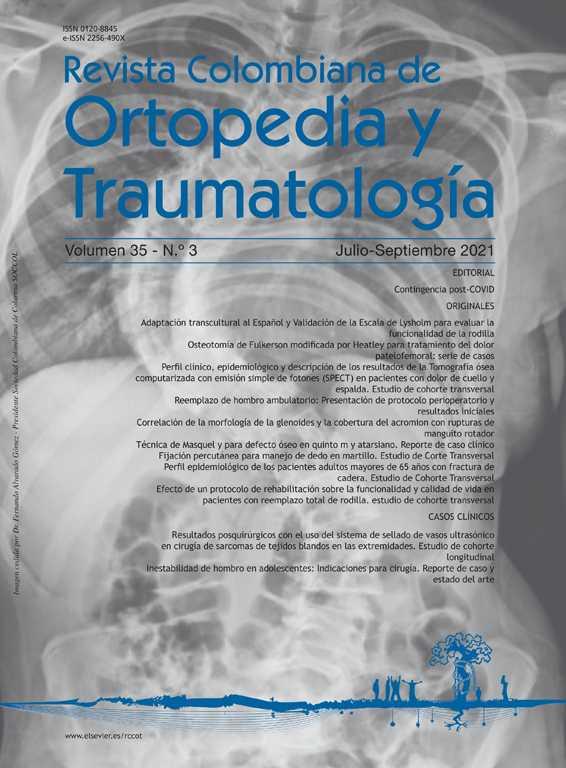Clinical and epidemiological profile and description of the results of bone single photon emission computed tomography (SPECT) in patients with neck and back pain: Cross-sectional study
DOI:
https://doi.org/10.1016/j.rccot.2021.08.001Keywords:
Tomography, Emission-computed, Single-photon, SPECT, Cervical pain, Low back pain, EpidemiologyAbstract
Background: SPECT bone scan with is an important diagnostic tool in patients with neck and back pain. It is a functional test that anticipates structural changes in some spinal pathologies. Aim of study is to define the epidemiological profile of patients with chronic and/or subacute axial spine pain.
Methods: A retrospective descriptive study whose general objective is to present the clinical and sociodemographic characteristics, as well as the results of the SPECT scans of the patients who visited the Hospital in a period of time with a diagnosis of neck or back pain and were requested such an examination.
Results: Seventy-seven patients met the inclusion criteria. The median age was 48 years, 57.1% were men and 42.9% were women. Fifty-seven patients had a single location of pain (74%) and 20 patients had multiple location (26%), the affected segments were 57 lumbar (74%), cervical 15 (19.5%) and sacrum 1 (1.3%). The most common pre-examination diagnostic impression was facet disease in 25 cases for 32.5%. Regarding the SPECT results, the radiopharmaceutical captured on 48 occasions (62.3%) and the sites where it captured the radiopharmaceutical were distributed as follows: facets 13 (16.9%), vertebral body 28 (36.4%), pars interarticularis 3 (3.8%).), intervertebral disc 1 (1.3%), 3 (3.8%) captured in sites other than the spine. The diagnostic concordance index after SPECT occurred in 33 cases (42.85%).
Discussion: Most of the uptake scans were in the vertebral bodies, beneath the context of our hospital, as a trauma center, and that many of the patients had pain secondary to traffic accidents or work behavior accidents, they are correlated with micro-fractures or bone contusions. SPECT scintigraphy continues to be a functional test that can help us in the diagnosis, prognosis and therapeutic approach of patients with axial spinal pain in its different stages.
Evidence Level: III
Downloads
References
Chung CT, Wang CF, Chou CS, et al. Single photon emission computed tomography (SPECT) for low back pain induced by extension with no root sign. J Chin Med Assoc. 2004;67:349-54.
Bogduk N. Practical guidelines and protocols. Lumbar medial branch blocks. Proceedings of ISIS 9th Annual Scientific Meeting, September 14-16. 2001. Boston, MA.
Hedrich C, Hofmann S, Pablik J, Morvach H. Autoinflamatory Bone Disorders with Special Focus on Chronic Recurrent Multifocal Osteomyelitis (CRMO). Pediatric Rheumatology. 2013;11:47.
Hernandez N, Reina EA, Herrera-Arbelaez JM. Validación de la prueba de extensión en bípedo de los isquiotibiales (PEBI) para el diagnóstico diferencial del dolor lumbar inespecífico mecánico (DLIM). Rev Col Or Tra. 2017;31:49-54, http://dx.doi.org/10.1016/j.rccot.2017.03.001.
Anderson K, Sarwark JF, Conway JJ, et al. Quantitative assessment withSPECT imaging of stress injuries of the pars interarticularis and response to bracing. J Ped Orthop. 2000;20:28-33.
Jain A, Jain S, Agarwal A, Gambhir S, Shamshery C, Agarwal A. Evaluation of Efficacy of Bone Scan With SPECT/CT in the Management of Low Back Pain: A Study Supported by Differential Diagnostic Local Anesthetic Blocks. Clin J Pain. 2015;31:1054-9.
Cornwel B. The emergency department evaluation, management and treatment of back pain. Emerg Med Clin N Am. 2010;28:811-39, http://dx.doi.org/10.1016/j.emc.2010.06.001.
Roger C, Loeser J. Interventional Therapies, Surgery, and Interdisciplinary Rehabilitation for Low Back Pain. An Evidence- Based Clinical Practice Guideline From the American Pain Society Spine. 2009;34:1066-77.
Lee I, Budiawan H. The value of SPECT/CT in localizing pain site and prediction of treatment response in patients with chronic low back pain. 2014;29:1711-6.
Dolan AL, Ryan PJ, Arden NK, Stratton R, Wedley JR, Hamann W, Fogelman I, Gibson T. The value of SPECT scans in identifying back painlikely to benefit from facet joint injection. Br J Rheumatol. 1996;35:1269-73.
Makki D, Khazim R, Zaidan AA, Ravi K, Toma T. Single photon emission computerized tomography (SPECT) scan-positive facet joints and other spinal structures in a hospital-wide population with spinal pain. Spine Journal. 2010;10:58-62.
Stirling A, Worthintong T, Rafiq M, Lambert PA, et al. Association between Sciatica and Propionibacterium Acnes. Lancet. 2001;357:2024-5.
Manchikanti L, Helm S, Singh V, et al. An algorithmic approach for clinical management of chronic spinal pain. Pain Physician. 2009;12:225-64.
Hedrich C, Hofmann S, Pablik J, Morvach H. Autoinflamatory Bone Disorders with Special Focus on Chronic Recurrent Multifocal Osteomyelitis (CRMO). Pediatric Rheumatology. 2013; 11:47.
Daoud Ma, Rabi K. Single photon emission computerized tomography (SPECT) scan-positive facet joints and other spinal structures in a hospital-wide population with spinal pain. The Spine Journal. 2010;10:58-62.
Enthoven WTM, Geuze J, Scheele J, Bierma-Zeinstra SMA, Bueving HJ, Bohnen AM, et al. Prevalence and ‘‘Red Flags’’ Regarding Specified Causes of Back Pain in Older Adults Presenting in General Practice. Phys Ther [Internet]. 2016;96:305-12.
Russo VM, Dhawan RT, Dharmaraj N, Baudracco I, et al. Hybrid Bone Single Photon Emission Computed Tomography Imaging Evaluation of Chronic Low Back Pain: Correlation with Modic Changes and Degenerative Disc Disease. World Neurosurgery. 2017;03:816-23.
Chou R, Atlas S. Nonsurgical Interventional Therapies for Low Back Pain A Review of the Evidence for an American Pain Society Clinical Practice Guideline. Spine. 2009;34:1078-93.
Dean C, Samartzis D, et al. Degenerative Magnetic Resonance Imaging Changes in Patients With Chronic Low Back Pain Spine. 2011;36:S43-53.
Chou R, Qaseem A, Owens DK, et al. Diagnostic imaging for low back pain: advice for high-value health care from american college of physicians. Ann Intern Med. 2011;154:181-9.





